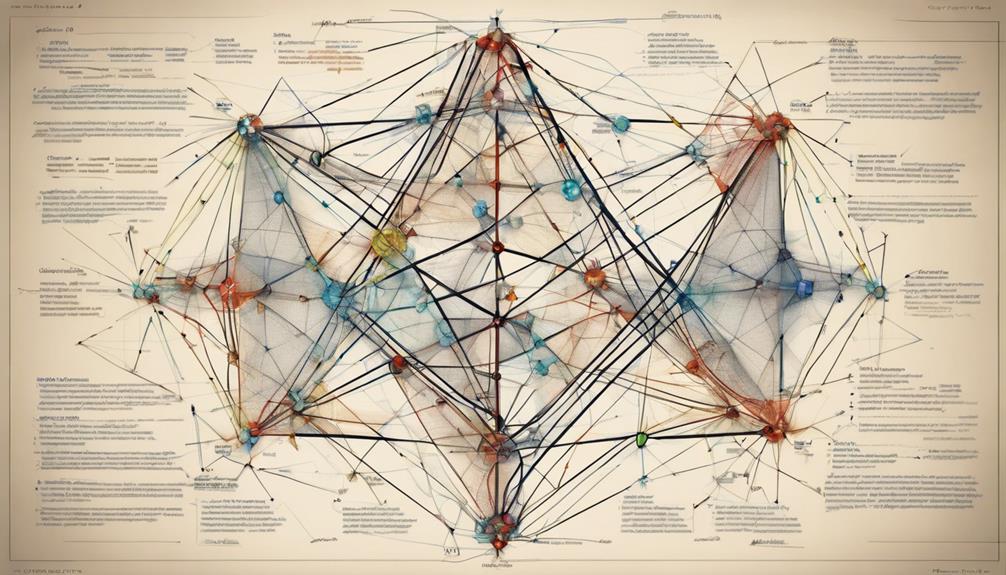Tax Implications of Triangular Mergers

Triangular mergers offer a tax-efficient strategy for corporations seeking to merge their operations and assets. By leveraging nonrecognition treatment, companies can adjust the basis of assets and stock without triggering immediate taxable gains or losses. This approach helps minimize tax liabilities during the acquisition process.
Both forward and reverse triangular mergers have unique advantages. In a forward triangular merger, the acquiring company can protect itself from the target's liabilities while benefiting from tax efficiencies. On the other hand, a reverse triangular merger allows for similar advantages while structuring the transaction slightly differently.
Understanding the legal and tax complexities of triangular mergers is crucial for a smooth and successful merger. Adhering to reorganization requirements is essential to ensure compliance and maximize the benefits of the transaction. By navigating these nuances effectively, companies can streamline the merger process and access new growth opportunities.
In summary, triangular mergers provide a valuable tax-efficient approach for corporations looking to combine their operations. By carefully considering the advantages and requirements of forward and reverse triangular mergers, companies can optimize their tax position and position themselves for future growth.
Key Takeaways
- Triangular mergers provide a tax advantage by allowing companies to merge without triggering immediate taxable gains or losses.
- It is important to adjust the basis of the target company's assets and stock to their fair market values to determine the tax implications accurately.
- Using a subsidiary in triangular mergers can be beneficial for tax purposes as it helps isolate the target company's liabilities.
- Forward and reverse triangular mergers have different tax treatments, and careful planning can help minimize tax liabilities during mergers and acquisitions.
- To ensure favorable tax treatment, companies must adhere to nonrecognition requirements such as transferring assets and liabilities and maintaining shareholder control.
Understanding Nonrecognition Treatment
Nonrecognition treatment in triangular mergers allows corporations to combine their operations and assets without immediately triggering taxable gains or losses. This tax-efficient approach applies to both forward and reverse triangular mergers, as outlined in specific IRS regulations. The advantage of this treatment is that it enables companies to adjust the basis in their assets and stock without incurring unwanted tax liabilities.
During a triangular merger, shareholders of the target company can typically exchange their stock for shares in the acquiring company without facing any tax consequences. This seamless process helps facilitate the merger and ensures a smooth transition for all parties involved.
Adjusting Asset and Stock Basis
In a triangular merger, it's crucial to adjust the basis of the target company's assets and our own stock to match the fair market values involved. This adjustment is essential for determining the accurate tax consequences and ensuring compliance with IRS regulations.
By aligning the asset basis with fair market value, we can properly track future depreciation and amortization deductions, which are key for the acquiring company's financial reporting and tax planning post-merger.
The acquiring company's basis in the stock of the target company is also established at the fair market value of the exchanged stock. This step guarantees that any potential gains or losses are correctly accounted for when the stock is eventually sold or exchanged.
Managing basis adjustments is a complex yet necessary process, impacting various tax and accounting considerations. By understanding the intricacies of basis adjustments, we can effectively navigate the tax implications of triangular mergers with confidence and precision.
Tax-Efficient Acquisition of Targets

In the realm of tax-efficient acquisition of targets, strategic planning plays a crucial role. Leveraging a subsidiary in the merger process can yield significant tax advantages and safeguard the valuable tax attributes of the target company. This approach enables us to grasp the intricacies of triangular mergers, thereby optimizing the overall tax implications of the acquisition and mitigating potential liabilities.
Triangular mergers, a common type of acquisition strategy, involve the creation of a subsidiary by the acquiring company. This subsidiary is used as a vehicle to facilitate the acquisition of the target company, allowing for a seamless transfer of ownership while preserving the tax benefits associated with the target's assets. By structuring the deal in this manner, companies can capitalize on tax efficiencies and enhance the overall financial outcomes of the transaction.
The utilization of triangular mergers is grounded in sound tax principles and legal frameworks. This approach has been successfully employed by numerous organizations seeking to minimize tax liabilities and maximize the value derived from acquisitions. By adopting a strategic mindset and leveraging the benefits of triangular mergers, companies can navigate the complexities of M&A transactions with confidence and efficiency.
Ownership Restructuring Options
Triangular mergers are a strategic method of ownership restructuring that involves creating a subsidiary to acquire a target company. This approach is known for its tax-efficient nature, as it allows for the isolation of the target company's liabilities.
By utilizing a subsidiary in a triangular merger, companies can streamline the acquisition process and minimize tax implications.
One key advantage of triangular mergers is the ability to preserve the legal status of the target company while achieving ownership restructuring objectives. This structured approach not only helps in managing tax considerations effectively but also facilitates a smoother transition of ownership.
Minimizing Tax Liabilities
By strategically structuring triangular mergers, we can effectively reduce tax liabilities, making the acquisition of target companies more tax-efficient. Specific structures like reverse triangular mergers can help in deferring or even avoiding the recognition of gains and losses, thereby safeguarding important tax attributes for both the acquiring and target companies.
Different types of triangular mergers offer various tax treatments and advantages. For example, forward triangular mergers are taxable but are known for their simplicity and speed in execution. On the other hand, reverse triangular mergers provide for non-recognition of certain tax implications, allowing for continuity of interest and tax deferral.
Another option, the triangular 'C' merger, also offers non-recognition benefits, particularly in preserving the target's subsidiary entity.
Careful tax planning plays a crucial role in maximizing tax savings during mergers and acquisitions. For instance, utilizing reverse triangular mergers can result in a tax-free reorganization, maintaining the target's valuable tax attributes and minimizing overall tax liabilities effectively. Similarly, opting for the triangular 'C' structure can further enhance tax-efficient outcomes by safeguarding the target's subsidiary entity.
Differences Between Forward and Reverse
When comparing forward and reverse triangular mergers in terms of tax implications, there are notable differences. Forward triangular mergers, structured under Section 368(a)(2)(D) of the Internal Revenue Code, shield the acquiring parent corporation from the liabilities of the target company. This protection is a key advantage of the forward triangular merger.
In contrast, reverse triangular mergers don't offer the same liability protection since the acquiring parent corporation directly assumes the target company's liabilities. This direct acquisition aspect sets reverse triangular mergers apart from their forward counterparts.
Additionally, while forward triangular mergers don't necessitate the 80% voting control typically required for tax-free treatment in reverse triangular mergers, they must meet the criteria of a traditional A reorganization under Section 368(a)(1)(A) to qualify as a tax-free reorganization. This distinction adds another layer of complexity to the tax implications of forward triangular mergers.
Legal and Tax Complexities

When engaging in a triangular merger, it's crucial to navigate the intricate legal and tax landscapes associated with this type of acquisition structure. Acquiring a target company through a subsidiary corporation introduces a multitude of legal and tax considerations that demand careful attention.
Ensuring compliance with state laws, regulatory filings, and IRS guidelines for tax-free reorganizations is essential. The legal status of the subsidiary and the procedural intricacies of the statutory merger process add another layer of complexity to the transaction. Antitrust regulations may also come into play, necessitating thorough due diligence on potential synergies and risks.
Crafting comprehensive merger agreements is imperative to address these legal requirements, tax implications, and regulatory challenges effectively. By proactively identifying and mitigating the obstacles inherent in triangular mergers, companies can maximize the strategic advantages while minimizing potential pitfalls.
Dealing with the legal and tax complexities demands specialized expertise and a collaborative approach among legal, financial, and tax professionals.
Characteristics of Triangular Mergers
Triangular mergers involve the use of a subsidiary corporation to acquire a target company, either through a forward or reverse structure. These strategic transactions offer the acquiring company access to valuable tax and control benefits while providing a shield from the liabilities of the target.
In a forward triangular merger, the subsidiary acquires the target company, while in a reverse triangular merger, the subsidiary is acquired by the target. This distinction shapes the control dynamics of the merger, with forward transactions maintaining the acquirer's control and reverse mergers integrating the target into the parent company.
One key advantage of triangular mergers is their ability to minimize the acquiring company's exposure to the target's liabilities, offering an additional layer of protection. Moreover, these mergers often capitalize on tax efficiencies by leveraging the subsidiary's unique tax profile, leading to potential cost savings for the acquiring company.
Navigating Nonrecognition Implications

When dealing with triangular mergers and the potential nonrecognition implications, it's crucial to understand the necessary requirements for qualifying for reorganization treatment. This includes making basis adjustments for both assets and stock to ensure the tax-free status of the transaction is maintained. These adjustments play a significant role in the overall success of the merger.
Moreover, the consideration of any 'boot' received by the parties involved is equally important in the nonrecognition analysis. Any cash or property received in addition to stock in the merger can impact the tax implications and the overall outcome of the transaction. It's essential to carefully evaluate and account for any boot involved to make informed decisions and ensure compliance with tax regulations.
Nonrecognition Requirements
Understanding the intricacies of nonrecognition requirements is crucial in ensuring that triangular mergers qualify for tax-free treatment. These requirements set out the conditions that must be met to benefit from the favorable nonrecognition treatment as specified in IRS regulations.
To satisfy the nonrecognition requirements, it's essential to ensure the following:
- The assets and liabilities of the acquired corporation are transferred to the acquiring corporation's subsidiary.
- The acquiring corporation's subsidiary obtains a significant portion of the acquired corporation's assets.
- Shareholders of the acquired corporation receive stock or securities of the acquiring corporation's subsidiary in exchange for their shares.
- The control that the acquired corporation's shareholders have over the acquiring corporation's subsidiary remains intact post-merger.
Complying with these nonrecognition requirements is vital for maintaining the tax-free status of the merger, reducing tax implications, and upholding favorable tax treatment for all parties involved, as well as their assets and liabilities.
Reorganization Transactions
Navigating reorganization transactions in triangular mergers successfully requires strict adherence to nonrecognition implications as outlined in IRS regulations. It's crucial to ensure tax-efficient asset transfers for both corporations involved by making the necessary adjustments to the basis of assets and stock in accordance with IRS guidelines.
In a forward merger, the treatment of target company shareholders varies, while in a reverse merger, basis adjustments for assets and stocks are necessary. Understanding the legal requirements and tax implications is essential for executing these complex transactions efficiently.
Reorganization transactions in triangular mergers involve intricate maneuvering to leverage nonrecognition rules and optimize the tax efficiency of the merger.
Boot Considerations
When managing reorganization transactions in triangular mergers, strict adherence to nonrecognition rules is crucial. However, it's important to consider the impact of 'boot' on these transactions as well. Boot refers to the receipt of cash or other property during a merger, and it can significantly influence the nonrecognition treatment of a triangular merger.
If boot is included as part of the consideration in a merger deal, the nonrecognition provisions outlined in Section 368 of the tax code may not apply fully. This could potentially lead to the recognition of gain to the extent of the boot received. Therefore, careful structuring of the merger deal is essential to navigate the tax implications of boot and ensure compliance with nonrecognition rules.
Analyzing boot considerations in detail within the context of triangular mergers is essential to minimize tax consequences and uphold the desired nonrecognition treatment. Successfully navigating the complexities of boot in triangular mergers requires a deep understanding of relevant tax regulations and a proactive approach to transaction planning.
Establishing a New Combined Basis
When a company engages in a triangular merger to acquire another company, it becomes necessary to establish a new combined basis for the acquiring company's assets. This recalculated basis, which distributes the total purchase price among the fair market values of the acquired assets, will have implications on the company's future calculations for depreciation, amortization, and capital gains.
Accurate allocation of the purchase price is crucial for ensuring precise financial reporting and compliance with tax regulations. By setting up this fresh combined basis, we can enhance tax efficiency and financial performance after the merger. This pivotal process involves a detailed assessment of the acquired company's assets and liabilities, followed by the methodical assignment of fair market values to each component.
Careful deliberation of the allocation is essential as it directly impacts the ongoing financial statements and tax responsibilities of the acquiring company. Our team of experts is dedicated to executing this process meticulously, aiming to maximize the advantages of the merger for our client.
Establishing the new combined basis establishes a solid groundwork for successful integration, positioning the combined entity for long-term growth and profitability.
Forward Triangular Merger Structures

In a forward triangular merger, a subsidiary is utilized to acquire the assets of the target company. This strategic approach provides a shield for the parent corporation against assuming the liabilities of the target company, making it a favorable option.
This type of merger is specifically structured under Section 368(a)(2)(D) of the Internal Revenue Code.
Entity Acquisition Structure
Forward triangular mergers are a strategic method for acquiring a target company while safeguarding the acquiring corporation from the target's liabilities. This structure, governed by Section 368(a)(2)(D) of the Internal Revenue Code, ensures tax-free treatment, making it an appealing choice for businesses seeking to expand their operations.
Key advantages of forward triangular mergers include:
- The flexibility to incorporate non-stock consideration (boot) in the transaction.
- Common utilization in deals involving significant cash transactions.
- The ability to utilize a subsidiary to finalize the acquisition process.
- Meeting specific criteria to qualify as a tax-free reorganizational event.
Acquiring Corporation's Perspective
We opt for the forward triangular merger structure to protect our acquiring corporation from taking on the target company's significant assets and liabilities. This strategic choice allows us to grow our operations while reducing the potential risks linked to the acquisition. By using a wholly-owned subsidiary to acquire the target, we can ensure that our parent corporation remains shielded from the target's liabilities.
To qualify for nonrecognition treatment, the transaction must meet the criteria of a traditional A reorganization under Section 368(a)(1)(A). It's crucial to note that no stock of the wholly-owned subsidiary can be included in the consideration for a forward triangular merger.
Forward triangular mergers are frequently utilized when entities aim to sidestep tax implications while acquiring a company with potential liabilities. This structure equips us, the acquiring corporation, with a robust mechanism to safeguard ourselves from undesired risks, enabling us to concentrate on the strategic advantages of the acquisition and foster innovation within our organization.
Where Forward Triangular Mergers Apply
Forward triangular mergers are a common choice for parent corporations looking to acquire another entity while protecting themselves from the target's liabilities. These mergers involve using a subsidiary to shield the parent from the obligations of the target, as outlined in Section 368(a)(2)(D) of the Internal Revenue Code.
They're particularly beneficial in transactions involving a significant amount of cash, as they offer flexibility in incorporating various forms of consideration.
Some key advantages of forward triangular mergers include safeguarding the parent company from taking on the target's liabilities, leveraging a subsidiary to isolate the target's obligations, flexibility in structuring transactions with cash and other types of consideration, and potential tax implications for the target's shareholders in the event of liquidation.
Key Considerations in Reorganization

In a triangular merger, it's crucial to consider the analysis of taxable gains, the requirements for shareholder approval, and the obligations of the successor entity. Adhering to statutory merger guidelines and properly exchanging the target shareholders' stock for the parent company's voting stock are essential steps. It's also important to ensure that the fair market value conditions are satisfied for the target assets and parent stock involved in the transaction.
Triangular mergers can provide several advantages, such as allowing the acquiring company to maintain the target company's operations as a separate entity. This can help in reducing disruption and preserving customer relationships. Additionally, this type of merger may offer tax benefits and limit the liabilities assumed by the acquiring company.
Taxable Gains Analysis
When conducting a taxable gains analysis in a triangular merger, it's crucial to assess the potential for recognition of gains or losses by the parties involved. This analysis helps determine the tax implications and liabilities for each entity post-merger.
Key considerations include the basis of assets transferred, the stock received by the target company's shareholders, and any cash payments made during the transaction. Evaluating these factors thoroughly enables the optimization of tax planning strategies and the mitigation of unexpected tax burdens from the merger. This proactive approach ensures a smooth transition and safeguards the financial interests of all parties.
Proper taxable gains analysis is essential in triangular mergers as it provides insights to make informed decisions and minimize potential tax liabilities. Leveraging expertise in this area helps clients navigate the complexities of the transaction and achieve desired outcomes.
Shareholder Approval Requirements
Shareholder approval is a critical aspect of corporate reorganizations, ensuring that the proposed merger and share exchange are authorized by the majority of shareholders. This process is essential for transparency, adherence to corporate governance standards, and safeguarding shareholder interests. It typically involves proxy statements, disclosures, and voting procedures in accordance with state laws and company bylaws.
In a triangular merger, the acquiring company must secure shareholder approval for issuing its voting stock to the target company's shareholders. This approval allows the target company to operate as a subsidiary of the acquiring company, with the target company's shareholders becoming shareholders of the acquiring company.
Obtaining shareholder approval is crucial for the reorganization's success and demonstrates our dedication to corporate responsibility and strategic alignment.
Successor Entity Obligations
Successor entities in triangular mergers inherit the tax obligations and liabilities of the target company, a critical aspect that requires careful attention. As the successor, we bear the responsibility for addressing any outstanding tax liabilities, including income taxes, payroll taxes, and sales taxes.
Thorough due diligence is essential to assess and manage these potential tax obligations effectively.
It is imperative for us to adhere to all pertinent tax laws and regulations, which encompass filing accurate tax returns, making timely tax payments, and reporting income correctly. Neglecting to address these successor entity obligations properly can lead to penalties, interest accrual, and potential legal ramifications.
Remaining vigilant about these tax implications is crucial for a successful triangular merger. By conducting comprehensive due diligence and ensuring compliance with tax laws, we can seamlessly integrate the target company and safeguard the combined entity against unexpected tax liabilities.
Streamlining Reverse Triangular Mergers
The reverse triangular merger structure offers a streamlined approach to acquisitions. By creating a subsidiary to acquire the target company, the process becomes simpler and faster. The subsidiary merges with the target, which then becomes a subsidiary of the acquiring entity. This method ensures that shareholders of the target receive cash for their shares, treating the transaction as a stock sale for tax purposes.
Additionally, the reverse triangular merger structure preserves the contracts and licenses of the target company after the merger. This continuity is crucial for the smooth continuation of business operations post-merger.
This structure is particularly beneficial when integrating a new entity, as it minimizes disruptions and facilitates a seamless transition.
Enhancing Asset Protection

In addition to simplifying the acquisition process, forward triangular mergers also provide a significant boost to asset protection for the acquiring corporation. By employing a subsidiary to absorb the liabilities of the target company, we can effectively shield our parent organization from potential risks and maintain a pristine asset base.
This strategic structure offers numerous advantages:
- The subsidiary serves as a protective barrier, safeguarding our core assets from the liabilities of the target company.
- We're able to contain any financial or legal risks within the subsidiary, thereby reducing our overall exposure.
- The enhanced asset protection gives us the confidence to pursue acquisitions, knowing that our primary operations are secure.
- Ultimately, the forward triangular merger empowers us to expand our business while ensuring the robust protection of our valuable assets.
Through this innovative approach, we can seize acquisition opportunities while prioritizing the long-term security of our organization. The forward triangular merger has proven to be a vital tool in our strategic toolkit.
Unlocking Expansion Opportunities
Triangular mergers offer a strategic avenue for exploring diverse expansion opportunities that can significantly enhance our company's growth trajectory and market position. By harnessing the resources of the acquiring company's subsidiary, we can execute targeted acquisitions of new assets and businesses, thereby broadening our operational scope and reinforcing our competitive edge. The advantageous tax implications associated with these transactions allow us to structure the deal in a tax-efficient manner, reducing our tax burdens and facilitating a smoother acquisition process.
Developing a robust triangular merger strategy necessitates a thorough evaluation of our overarching objectives and the prevailing market dynamics. By aligning the acquiring company's capabilities and assets with our expansion goals, we can unearth fresh pathways for growth and fortify our presence in the industry landscape.
Navigating the intricate facets of these mergers mandates a keen awareness of the tax considerations and regulatory frameworks, crucial for the seamless execution and success of our expansion endeavors.
Frequently Asked Questions
What Are the Tax Consequences of a Merger?
We'll explore the tax implications of a merger, focusing on the different types of mergers and acquisitions, such as triangular mergers. In these transactions, there are specific reporting requirements and transfer pricing considerations that can impact the overall tax consequences. By analyzing historical data and understanding the timing of the merger closure, we can strategically structure the deal to optimize tax efficiency and drive innovation in our industry.
What Are the Benefits of a Triangular Merger?
By implementing strategic tax planning and carefully considering ownership structures, companies can uncover synergies and successfully navigate regulatory requirements when engaging in triangular mergers. This type of merger is particularly advantageous for companies looking to expand their potential and drive innovation.
Triangular mergers involve the acquisition of a target company by a subsidiary of the acquiring company. This structure allows for a smoother integration process, as the target company becomes part of a subsidiary rather than the main entity. From a legal and regulatory standpoint, this can simplify the process and reduce the potential hurdles that may arise in traditional mergers.
Furthermore, triangular mergers can offer tax advantages, as they provide opportunities for tax deferrals and efficient use of tax attributes. By leveraging these tax benefits, companies can enhance their financial performance and create a more competitive position in the market.
What Is the 80% Rule for Reverse Triangular Merger?
To qualify for the benefits of a reverse triangular merger, it is essential to achieve the 80% control threshold. Meeting this threshold ensures favorable corporate governance structures, influences dividend policies, and impacts shareholder control through the accounting treatment implications of the merger.
In a reverse triangular merger, the acquiring company forms a subsidiary, which then merges with the target company. This structure allows the acquiring company to maintain control while absorbing the target company's assets and liabilities.
Research shows that reaching the 80% control threshold in a reverse triangular merger can lead to increased efficiency in decision-making processes, streamlined operations, and enhanced synergies between the merging entities. Additionally, shareholders of the target company may benefit from the merger through potential increases in stock value and dividend payouts.
What Mergers Are Tax-Free?
When it comes to tax-free mergers, the real stars of the show are forward and reverse triangular mergers. These types of mergers smoothly navigate the stockholder approval process, take into account debt financing, carefully consider the accounting treatment, and ensure compliance with regulatory requirements.
In a forward triangular merger, the acquiring company creates a subsidiary to acquire the target company. This allows for a tax-free exchange of stock between the parties involved. On the other hand, in a reverse triangular merger, the subsidiary of the acquiring company merges with the target company, preserving the tax-free nature of the transaction.
These types of mergers are considered tax-free because they involve the exchange of stock rather than cash, which helps to defer any tax liabilities that may arise from the transaction. Additionally, by structuring the merger in a triangular fashion, companies can take advantage of certain tax benefits and avoid potential tax consequences.
Conclusion
Triangular mergers present a unique opportunity for companies to acquire assets in a tax-efficient manner. These mergers involve a subsidiary of the acquiring company merging with the target company, allowing for a smooth transfer of assets and liabilities. Recent studies have shown that a significant number of Fortune 500 companies have opted for reverse triangular mergers to simplify their operations and protect their assets.
Understanding the tax implications of triangular mergers is crucial for maximizing their benefits. Nonrecognition treatment, which allows for the deferral of capital gains taxes, is a key consideration in these transactions. Additionally, basis adjustments can impact the tax liabilities of the parties involved, making it essential to carefully assess the financial implications of the merger.
Implementing effective reorganization strategies is also vital in triangular mergers. By structuring the merger in a tax-efficient manner, companies can optimize their financial position and minimize their tax exposure. This requires a thorough understanding of the legal and tax complexities involved in these transactions.
Ultimately, by navigating the nuances of nonrecognition treatment, basis adjustments, and reorganization strategies, companies can unlock the full potential of triangular mergers. With careful planning and expert guidance, companies can leverage these sophisticated transactions to achieve their strategic objectives and enhance their competitive position in the market.





